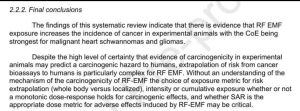BREAKING NEWS: WHO EMF Project review concluded that RF EMF exposure increases the incidence of cancer in experimental animals.
Published on 25 April 2025

EMFSA April 2025 Newsletter
Excerpt:
This article is part of a special issue entitled: ‘WHO RF EMF SRs’ published in Environment International.
The review, published on 25 April 2025 (Effects of radiofrequency electromagnetic field exposure on cancer in laboratory animal studies), concluded that RF EMF exposure increases the incidence of cancer in experimental animals. The certainty of evidence (CoE) was rated high for rare tumors in the heart (malignant schwannomas) and brain (gliomas).
In 2011, the IARC Monograph Program evaluated RF EMF and classified it as “possibly carcinogenic to humans” (Class 2B), based on limited evidence of carcinogenicity in humans and experimental animals (IARC 2013). This new analysis provides additional support for animal carcinogenicity, particularly referencing studies published after the IARC review (Falcioni et al., 2018; National Toxicology Program, 2018b).
Importantly, the findings reinforce that evidence of carcinogenicity in animals is predictive of potential hazards to humans. However, the authors noted in the review that risk extrapolation remains complex without a fully understood mechanism of RF EMF carcinogenicity. Challenges include determining the correct exposure metrics and understanding dose–response relationships.
Temperature:
Although body heating was evaluated, small increases in core body temperature (less than 1 °C) at SAR levels above 1.5 W/kg cannot be entirely excluded.
Oxidative Stress:
Oxidative stress — a potential contributor to cancer development — has been demonstrated even at low SAR levels, suggesting mechanisms beyond simple heating effects.
The authors propose additional considerations comparing RF EMF-induced heating between animals and humans (Annex 2). However, they stress that this should not be interpreted as endorsement of the “temperature hypothesis,” nor does it suggest any temperature-related bias in their certainty assessments.
Schwann Cell Tumors:
The authors point out that Schwann cells, which form the protective sheath around nerves, are found throughout the body. Tumors arising from these cells — known as schwannomas — are the most common neoplasms of the peripheral nerve sheath. This category also includes neurofibromas, perineurinomas, granular cell tumors, and malignant peripheral nerve sheath tumors.
Vestibular schwannoma (also called an acoustic neuroma or acoustic neurinoma) has been linked to an increased risk in some human epidemiological studies (Cardis et al., 2010; Hardell et al., 2002; Hardell et al., 2003; IARC, 2013; Pettersson et al., 2014).
Need for Future Research:
- Current and upcoming 5G frequencies (3.5–60 GHz) are expected to be widely deployed long before new animal cancer data can influence exposure guidelines.
- Animal cancer studies take many years to design, conduct, and report, making it challenging to keep pace with technological advances.
Future studies should incorporate intermediate biological markers — such as serum stress hormones, reactive oxygen species (ROS) levels, heart rate, and other metabolic indicators — to better understand mechanisms of RF EMF carcinogenicity and identify vulnerable organs or systems.
Continue reading: https://mailchi.mp/emfsa/rf-emf-cancer-fertility-6g-insurance
Microwave News: WHO Review Finds Cancer Risk in RF-Exposed Animals At Odds with ICNIRP, Most Health Agencies
https://microwavenews.com/news-center/who-review-sees-rf-cancer-risk-animals
Scientific Experts Urge the FCC to Establish Science-Based Exposure Limits to Address Wireless Health Risks
2.2.2. Final conclusions

‘The findings of this systematic review indicate that there is evidence that RF EMF exposure increases the incidence of cancer in experimental animals with the CoE being strongest for malignant heart schwannomas and gliomas. Despite the high level of certainty that evidence of carcinogenicity in experimental animals may predict a carcinogenic hazard to humans, extrapolation of risk from cancer bioassays to humans is particularly complex for RF EMF. Without an understanding of the mechanism of the carcinogenicity of RF-EMF the choice of exposure metric for risk extrapolation (whole body versus localized), intensity or cumulative exposure whether or not a monotonic dose-response holds for carcinogenic effects, and whether SAR is the appropriate dose metric for adverse effects induced by RF-EMF may be critical.’
Published review 👉 https://www.sciencedirect.com/science/article/pii/S0160412025002338

